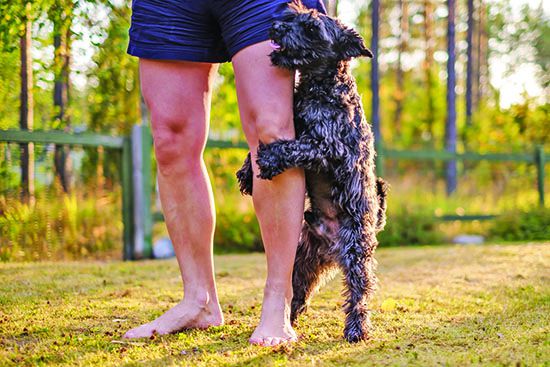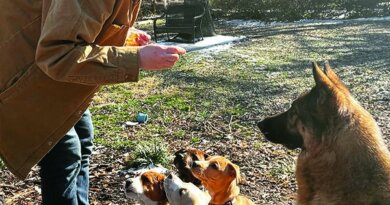Why Do Dogs Hump | Why is My Dog Humping
You may be embarrassed by your dog’s proclivity to mount other dogs, cushions or pieces of furniture, or even (horrors!) humans. You are not alone; dogs all over the world can be seen wrapping their front paws around what seems to us to be inappropriate targets and thrusting their pelvis in what appears to be sexual behavior.
Mounting and/or humping is a natural, normal canine behavior – and it’s not just male dogs who mount; female dogs do it too! – but it’s one that humans all over the world tend to get upset about. Sadly, many caretakers see the behavior as grossly unacceptable, and their dogs may suffer for it.
Such was the case in late March, when a North Carolina couple surrendered Fezco, their 5-year-old, 50-pound male Shepherd mix to their local shelter because they had observed him mounting another male dog and were aghast at the thought of having a “gay dog” in their home. The uneducated owners were apparently unaware that while there are a number of reasons why dogs “hump” other dogs, being gay is not considered to be one of them. (Happily, when this story made national news, the dog found a forever home with a gay couple elsewhere in North Carolina.)
The misinterpretation is somewhat understandable; humping sure looks like sex! But reproduction is only one of the many reasons your dog may mount dogs, humans, or objects, and those reasons are far more common than the intent to breed:
- Reproduction. If you’re intentionally trying to have your female dog impregnated, you’re happy to have humping happen. If not, manage the behavior by separating the dogs until the female’s heat period is done; then talk to your vet about spay/neuter surgery.
- Play. Yes friends, this can be a normal part of play interaction between dogs, including but not limited to puppies. As long as both puppies are enjoying the play and the mounting isn’t excessive to the point is becomes oppressive to the mountee, you can leave them alone and let them play.
- Stress and/or anxiety. Your dog may mount other dogs (or whatever) as a means to relieve stress. You’ll see this most often in dogs who tend to be stressed. Again, there’s no real harm in allowing the behavior in the moment, but you would do well to reduce stress in the dog’s world and address the generalized anxiety so he no longer feels the need to mount to try to relieve his stress.
- Excitement and/or arousal. Some dogs are inclined to mount when they get over-excited – for example, when visitors arrive at your home. You can manage this by putting your dog away in another room before (or when) people arrive and bringing him back out on leash when things have settled down. Keep him on leash for controlled greetings (restrain so he can’t mount visitors’ legs) and let him off leash only when he is over his initial excitement.
- Attention-seeking. Dogs are pretty good at figuring out what they need to do to get what they want. If they want your attention and you hustle over to stop them every time they mount someone or something – mission accomplished! The game is on, just like the dog who learns to pick up forbidden objects so you’ll chase after him. The answer: Find a different way to intervene when intervention is called for.
- Masturbation. This can be due to a medical issue – a urinary tract infection or allergies, perhaps, that cause the dog’s private parts to itch or be painful. It’s always a good idea to have your dog checked by your veterinarian to see if there are any medical issues causing or contributing to behavior challenges. But some dogs have learned that it feels good to hump a pillow, stuffed toy, or other animal – and behaviors that are self-reinforcing are likely to increase.
- Obsessive Compulsive Disorder (OCD). This is a very rare cause for mounting behavior, but it can happen. If your dog’s behavior doesn’t seem to fall into any of the above descriptions, if it’s difficult if not impossible to interrupt the behavior, and he’s doing it with a frequency and intensity that is damaging his quality of life, then it may be due to an OCD. If you suspect this, a visit to a qualified behavior professional is in order. (See “Obsessive Compulsive Disorder in Dogs,” September 2010.)
IT’S NOT DOMINANCE!
There is a fairly widespread misconception that mounting behavior is about being “dominant.” It’s not.
In behavior science, “dominance” is about gaining access to a mutually desired resource – it’s not about oppressing the other dogs in the social group. Sometimes one dog gets to be dominant in an interaction because they want the resource more and are less willing to defer, and sometimes the other dog gets the resource. Mounting has nothing to do with gaining access to a resource.
WHAT TO DO ABOUT IT
Just because mounting is a natural, normal behavior doesn’t mean you have to put up with your dog humping everything in sight! There are things you can do to decrease his need and opportunity to mount.
- Rule out or treat any possible medical contributors to the behavior. All your modification efforts will be for naught if a medical condition is driving his mounting behavior.
- Increase the amount of exercise your dog gets. This doesn’t have to be hours of hiking in the woods – you can use interactive games, cognition, and scent work to tire his brain as well as off-leash exercise to tire his body. This can help keep his excitement level down, so he feels less of a need to release his energy through mounting. Tired minds and bodies are less likely to need or want to run around humping. Increased exercise can also help reduce stress.
(For information about brain-engaging tools and exercises, see “The Best Food-Dispensing Toys,” WDJ April 2019; “How to Engage Your Dog’s Brain When Activity Is Restricted,” March 2021; and “How to Teach Your Dog to Play Nose Games,” September 2019.)
- Look for ways to reduce your dog’s stress levels. Manage his exposure to things that worry him and get rid of any stressors you’re able to (such as shock, choke, or prong collars; verbal or physical punishment; and other aversive training techniques). Also, use counter-conditioning and desensitization (CC&D, carefully pairing high-value reinforcers with things that worry him) to change his opinion of his stressors. (For information about reducing your dog’s stress, see “Counter-Conditioning and Desensitization,” March 2020, and “Stressed Out,” April 2020.)
- For dogs who mount others too persistently in play, occasionally use a “positive interrupt.” The idea is to move him away from the other dogs and give him several minutes of quiet time to reduce his arousal level. If you cheerfully interrupt every time your dog becomes too much of a pest to his playmates, he may learn to self-modulate his mounting behavior. At worst, you can use it to easily let him calm down while giving his play pals a break as needed.
My favorite positive interrupting exercise is “Walk Away,” which teaches a dog to not just leave alone the object of his interest, but also to return to you for a reinforcing treat. (See “How to Teach Your Dog to Just Walk Away!” September 2018.)
- If you haven’t already, make a commitment to good manners training for your dog. This may take the form of group classes, private training, or training on your own if you have these skills. Teach your dog how to greet people politely to reduce excitement mounting, as well as a multitude of other useful behaviors (Down, Touch, Go to Your Mat, etc.).
The more he responds to your cues for a variety of behaviors, the more easily you’ll be able to ask him for alternative, incompatible behaviors when he gets that humping gleam in his eye. Plus, the better the two of you can communicate, the less stressful life is for both of you! (And remember, the less stressed he is, the less likely to mount.)
- Finally, get ready to make some judgment calls. You’ll want to be able to determine which of your dog’s mounting behaviors might be innocuous and allowed to continue, and which need intervention and/or behavior modification assistance. Your friends will be relieved when they can come visit without having intimate relations with your dog, and your dog (and his friends) will be happy that they can engage in normal play activities.




